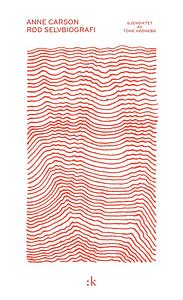You need to sign in or sign up before continuing.
Take a photo of a barcode or cover
medium-paced
challenging
emotional
reflective
medium-paced
Plot or Character Driven:
A mix
Strong character development:
Complicated
Loveable characters:
Complicated
Diverse cast of characters:
Yes
Flaws of characters a main focus:
Yes
Autobiography of Red is an innovative and unique book, but one that worked for me more on an intellectual level rather than an emotional one. I appreciated it and enjoyed many aspects, even if not all of its parts worked for me.
At its core is a novel told in free verse, a sort of reimagining of the story of Geryon, a three bodied and/or three-headed winged monster who is killed by Hercules as part of his tenth labour. The ancient Greek poet Stesichoros retold the myth from Geryon's point of view, and Carson riffs off that further. Her Geryon is red skinned and winged but also small, introverted, and lonely. He is bullied and then sexually abused by his older brother. As a teen, he meets Herakles, and the two form a friendship that develops into a sexual relationship, but then Herakles leaves, breaking Geryon's heart. As adults, their paths cross unexpectedly. The writing was impressive, even as some turns of phrase left me scratching my head if I thought too hard or wanted them to make literal sense. I found Geryon sympathetic, and despite my initial reservations, the winged monster/American teen mash-up seemed to work. His struggles with both his sexual and gender identities, his doomed relationship with Herakles, and the way he used arts, particularly photography, as a way to view the world and find himself means would make him relatable to many readers, yet the fantastical/mythological aspects are still strong.
The other parts of this novel - translated fragments of Stesichoros's poem, an imaginary interview, appendices, and a palinode - didn't really work for me. They felt overly academic, almost like a barrier to my comprehension that nearly dissuaded me from continuing. I am glad I wasn't put off, though. This book won't be a favourite but I am glad I read it.
This was my pick for the Ann-uary prompt (Read a book by an author call Ann) for the #ReadGoodChallenge.
At its core is a novel told in free verse, a sort of reimagining of the story of Geryon, a three bodied and/or three-headed winged monster who is killed by Hercules as part of his tenth labour. The ancient Greek poet Stesichoros retold the myth from Geryon's point of view, and Carson riffs off that further. Her Geryon is red skinned and winged but also small, introverted, and lonely. He is bullied and then sexually abused by his older brother. As a teen, he meets Herakles, and the two form a friendship that develops into a sexual relationship, but then Herakles leaves, breaking Geryon's heart. As adults, their paths cross unexpectedly. The writing was impressive, even as some turns of phrase left me scratching my head if I thought too hard or wanted them to make literal sense. I found Geryon sympathetic, and despite my initial reservations, the winged monster/American teen mash-up seemed to work. His struggles with both his sexual and gender identities, his doomed relationship with Herakles, and the way he used arts, particularly photography, as a way to view the world and find himself means would make him relatable to many readers, yet the fantastical/mythological aspects are still strong.
The other parts of this novel - translated fragments of Stesichoros's poem, an imaginary interview, appendices, and a palinode - didn't really work for me. They felt overly academic, almost like a barrier to my comprehension that nearly dissuaded me from continuing. I am glad I wasn't put off, though. This book won't be a favourite but I am glad I read it.
This was my pick for the Ann-uary prompt (Read a book by an author call Ann) for the #ReadGoodChallenge.
Graphic: Child abuse
I feel it might be the narrator, or the audiobook in general, but this isn't really hitting right for me right now. Probably try again another time.
one of the most enjoyable books i’ve read. i loved this and cannot wait to read it again.
Utterly original. Would make an excellent book club discussion book. I will be returning to this.
(I <3 volcanos.)
(I <3 volcanos.)
emotional
reflective
medium-paced
Plot or Character Driven:
Character
Strong character development:
Yes
Loveable characters:
Yes
Diverse cast of characters:
Yes
Flaws of characters a main focus:
Yes
3.75/5 stars for this novel in verse. I think I need to let myself sit with the story of Geryon a bit longer to let the message hit me, but I know I enjoyed my time with this tale even though it’s definitely not going to be everyone’s cup of tea.
The Autobiography of Red, written by the inventive and talented Anne Carson, is a unique and captivating novel that defies traditional conventions. Blending poetry, mythology, and fiction, Carson presents readers with a singular narrative experience that delves deep into the complexities of identity, love, and the power of art.
At the heart of the story is Geryon, a modern-day incarnation of the mythical creature from Greek mythology. Through a series of vividly rendered poems, Carson takes us on a lyrical journey through Geryon's life, exploring his formative experiences, his relationships, and his search for self-discovery. As Geryon navigates the challenges of his existence, his story unfolds with a poetic grace that invites readers to contemplate the nature of identity and the ways in which we construct and redefine ourselves.
Carson's writing style in The Autobiography of Red is enchanting and evocative. Her lyrical prose infuses every line with a vividness that brings Geryon's world to life. The unconventional structure of the novel, composed of short verse-like chapters, creates a rhythm that adds depth and nuance to the storytelling. Carson's command of language is truly remarkable, as she weaves together vivid imagery, metaphor, and allusion to craft a narrative that is both intellectually stimulating and emotionally resonant.
The exploration of love and desire is a central theme in The Autobiography of Red. Geryon's tumultuous relationships, particularly his passionate and complicated affair with Herakles, delve into the depths of longing, vulnerability, and the complexities of human connection. Carson's portrayal of these relationships is raw and honest, capturing the emotional intensity and the fragile nature of love.
One of the novel's standout qualities is its interplay between the contemporary and the mythological. Carson seamlessly blends elements of the ancient Greek myth of Geryon with a modern-day setting, infusing the narrative with layers of symbolism and metaphor. This juxtaposition creates a rich tapestry of themes and ideas, inviting readers to reflect on the enduring relevance of mythology and its ability to illuminate our own lives.
While The Autobiography of Red offers a unique and thought-provoking reading experience, some readers may find the nonlinear and fragmented structure of the narrative challenging to follow. The poetic language and the ambiguity of certain passages may require additional attention and interpretation. However, for those willing to engage with Carson's inventive style, the rewards are plentiful, as the novel encourages contemplation and invites readers to think beyond conventional storytelling boundaries.
In conclusion, The Autobiography of Red is a captivating and inventive work that pushes the boundaries of narrative and language. Anne Carson's poetic prowess and her ability to merge mythology and contemporary themes make this novel a rich and intellectually stimulating read. While its unconventional structure may pose a challenge for some readers, the depth of Carson's exploration of identity, love, and the power of art makes this book a rewarding and thought-provoking journey into the complexities of the human experience. The Autobiography of Red stands as a testament to Carson's skill as a writer and her ability to create a truly unique and memorable work of literature.
At the heart of the story is Geryon, a modern-day incarnation of the mythical creature from Greek mythology. Through a series of vividly rendered poems, Carson takes us on a lyrical journey through Geryon's life, exploring his formative experiences, his relationships, and his search for self-discovery. As Geryon navigates the challenges of his existence, his story unfolds with a poetic grace that invites readers to contemplate the nature of identity and the ways in which we construct and redefine ourselves.
Carson's writing style in The Autobiography of Red is enchanting and evocative. Her lyrical prose infuses every line with a vividness that brings Geryon's world to life. The unconventional structure of the novel, composed of short verse-like chapters, creates a rhythm that adds depth and nuance to the storytelling. Carson's command of language is truly remarkable, as she weaves together vivid imagery, metaphor, and allusion to craft a narrative that is both intellectually stimulating and emotionally resonant.
The exploration of love and desire is a central theme in The Autobiography of Red. Geryon's tumultuous relationships, particularly his passionate and complicated affair with Herakles, delve into the depths of longing, vulnerability, and the complexities of human connection. Carson's portrayal of these relationships is raw and honest, capturing the emotional intensity and the fragile nature of love.
One of the novel's standout qualities is its interplay between the contemporary and the mythological. Carson seamlessly blends elements of the ancient Greek myth of Geryon with a modern-day setting, infusing the narrative with layers of symbolism and metaphor. This juxtaposition creates a rich tapestry of themes and ideas, inviting readers to reflect on the enduring relevance of mythology and its ability to illuminate our own lives.
While The Autobiography of Red offers a unique and thought-provoking reading experience, some readers may find the nonlinear and fragmented structure of the narrative challenging to follow. The poetic language and the ambiguity of certain passages may require additional attention and interpretation. However, for those willing to engage with Carson's inventive style, the rewards are plentiful, as the novel encourages contemplation and invites readers to think beyond conventional storytelling boundaries.
In conclusion, The Autobiography of Red is a captivating and inventive work that pushes the boundaries of narrative and language. Anne Carson's poetic prowess and her ability to merge mythology and contemporary themes make this novel a rich and intellectually stimulating read. While its unconventional structure may pose a challenge for some readers, the depth of Carson's exploration of identity, love, and the power of art makes this book a rewarding and thought-provoking journey into the complexities of the human experience. The Autobiography of Red stands as a testament to Carson's skill as a writer and her ability to create a truly unique and memorable work of literature.








